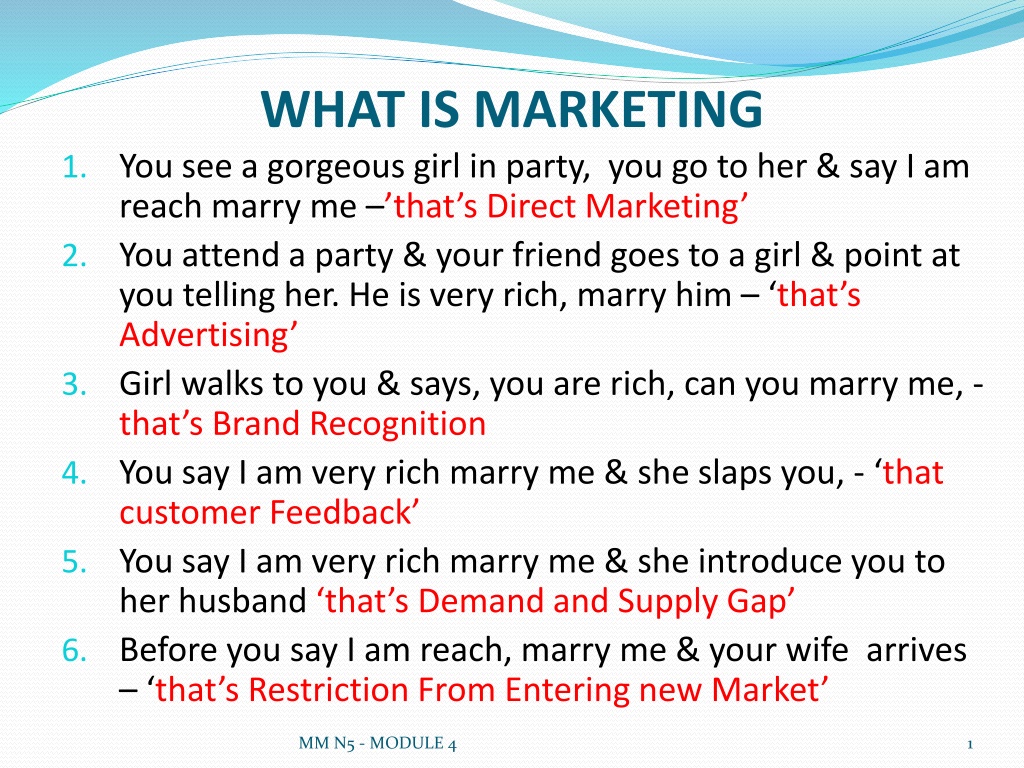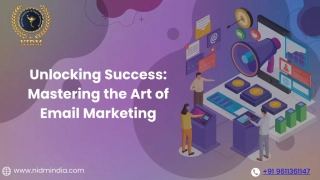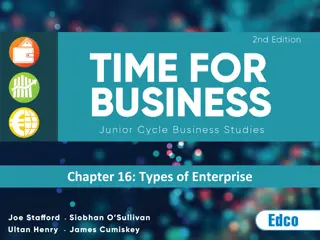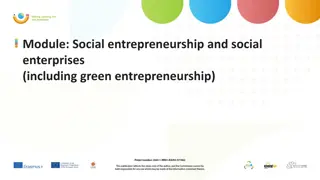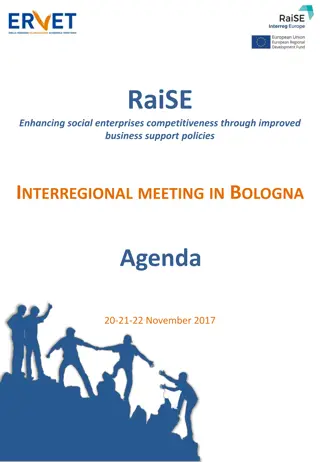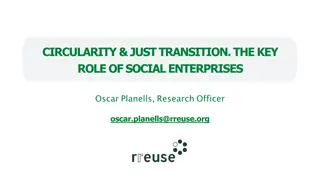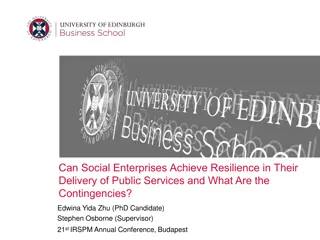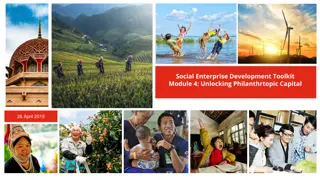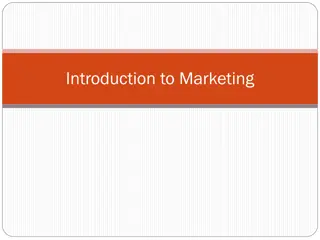Understanding Marketing Communication in Enterprises
Marketing communication plays a vital role in engaging with customers and promoting products/services effectively. This content explores various aspects, including direct marketing, advertising, brand recognition, customer feedback, demand-supply gap, and more. It delves into promotional policies, the communication process, promotional objectives, and the communication flow/model. Gain insights into the different promotional methods used, management of promotional mix, and advertising concepts.
Download Presentation

Please find below an Image/Link to download the presentation.
The content on the website is provided AS IS for your information and personal use only. It may not be sold, licensed, or shared on other websites without obtaining consent from the author. Download presentation by click this link. If you encounter any issues during the download, it is possible that the publisher has removed the file from their server.
E N D
Presentation Transcript
WHAT IS MARKETING 1. You see a gorgeous girl in party, you go to her & say I am reach marry me that s Direct Marketing 2. You attend a party & your friend goes to a girl & point at you telling her. He is very rich, marry him that s Advertising 3. Girl walks to you & says, you are rich, can you marry me, - that s Brand Recognition 4. You say I am very rich marry me & she slaps you, - that customer Feedback 5. You say I am very rich marry me & she introduce you to her husband that s Demand and Supply Gap 6. Before you say I am reach, marry me & your wife arrives that s Restriction From Entering new Market MM N5 - MODULE 4 1
PROMOTIONAL POLICY - MODULE 4 SO s for this module: Understand the role that communication fulfils during the constant interdependence between the enterprise and its environment. Explain the process that is used to communicate with the customer Broadly distinguish between the basic four kinds of promotional methods that can be used to communicate with the target market. Form an understanding of how the promotional mix is managed in the enterprise. Explain the role of advertising management and the basic concepts of advertising management. Identify the steps in an advertising campaign and to describe them shortly. MM N5 - MODULE 4 2
1. PROMOTION: Is any form of communication that can be used to inform, to persuade and to remind the consumer to buy the product or service sold by a certain enterprise. 1.1 I. advertising II. personal selling III. sales promotion IV.publicity The elements of promotional mix: MM N5 - MODULE 4 3
1.2 Promotional Objectives: to make the consumer aware of a new product. to convey information to convince the consumer to purchase the product or service to convince channel members to stock certain products to increase turnover to retain and to promote the image of the enterprise to proclaim specific, important activities to expand the product image to convey the price of products or services 1) 2) 3) 4) 5) 6) 7) 8) 9) MM N5 - MODULE 4 4
2. THE COMMUNICATION PROCESS: Definition: Communicationis the process whereby an organization or an individual makes contact within as well as outside the organization, by means of verbal, non-verbal or technological means. Communication can be divided into two main categories: interpersonal communication and mass communication. MM N5 - MODULE 4 5
2.1 THE COMMUNICATION FLOW/MODEL NOISE SENDER MESSAGE RECEIVERS #EXPLANATION OF COMMUNICATION FLOW - SLIDE NO 6 - 8 MM N5 - MODULE 4 6
2.1.1 The Sender/Source a) Is the communicator e.g. manufacturer or intermediaries who send the message. a) The source must have credibility. Credibility is a function of trustworthiness and expertise b) The marketer must ensure that he has identified the correct message idea, otherwise a lot of money and time will be wasted on an ineffective theme. MM N5 - MODULE 4 7
2.1.2Coding/Encoding OR message formulation: a) Formulation or encoding is the process by which the source s ideas and thoughts are put into a specific message by means of words, symbols, or images. The source must carefully select the symbols, words, images, colours, sounds etc. that will be used to compile the message. b) An important principle to remember is that the message that is seen or heard by the receiver is more important than the message that the source is trying to convey. 2.1.3 Message a) The message must be understood by the receivers. In multi-language countries, such as South Africa, choosing the correct symbols can pose a problem, since symbols must be familiar to the audience. MM N5 - MODULE 4 8
2.1.4 Message channel: a. This refers to the method by which the communicator travels from the source to the receiver. b. The communication channels can be divided into two broad types, namely personal and non-personal. c. Newspaper, TV, salesperson and rental store 2.1.5 The receiver/Audience. a. The receiver is the persons who receive the message. Usually they are the target market at whom the message is directed. 2.1.6 Decoding process a. The message is decoded by the receiver. Decoding is the process by which the receiver interprets and translates the message in order to understand it. MM N5 - MODULE 4 9
2.1.7Response/Reaction. a. Response is the receiver s reactions to the message. It can vary from only storing the information in his/her memory to action, such as purchasing the product. 2.1.8 Channel Noise a. Competitors advertisements is the biggest external factor that influence the success of the sender, receiver, reaction and feedback of the message (See diagram on page 119 &133) MM N5 - MODULE 4 10
3. Types of communication messages: a) Communication messages can be divided into two types - overt (explicit) and covert (implicit). b) An overt /explicit communication involves the use of language to establish its meaning. c) A covert/ implicit communication involves non- verbal communication such as body language, facial expression, attitudes and signals. MM N5 - MODULE 4 11
4. INFORMATION TRANSMISSION PROCESS: The following factors apply during the information conveyance process: perception, learning and convince 4.1 Perception: Perception, the way consumer interprets these sensory stimuli, becomes reality, although it is not necessarily according to the objectives reality. Perception becomes fact for the specific consumer. This means that he will react according to what he thinks 4.2 Consumer s learning ability influences their purchasing behavior. To be able to learn, the consumer must be motivated, s/he must pay full attention to the message and repetition of must occur. Learning MM N5 - MODULE 4 12
4.3 Persuasion Before the consumer can be persuaded by any marketing message, s/he must first receive the message, understood it and make it his own by giving in to it, therefore the consumer must change his/her attitude and actions to fit the message. MM N5 - MODULE 4 13
4.4 General objectives of promotion/marketing communication 4.4.1 Inform: informative advertisement can be used to stimulate dormant need and to develop the demand for a new product. Informative advertising includes: 1. Making people aware of the new product 2. Informing the general public of new product development 3. Recommending new product uses 4. Reducing consumer s fears 5. Informing the market of new price changes 6. Introducing available services 7. Correcting false impressions 8. Describing the way in which a product works 9. The building of the image of the enterprise MM N5 - MODULE 4 14
4.4.2 Persuade: 1. In order to convince the consumer or potential buyer of the differentiation qualities of the firm s products, persuasive message are used to create selective demand. 2. This method is used in the growth phase of the product. Persuasive advertising includes: a. Building brand preference b. Motivating the change to another brand c. Changing the consumer s perception of product changes d. Convincing consumers to buy the product immediately MM N5 - MODULE 4 15
4.4.3 Remind 1. Another inextricable objective of promotion is to constantly remind the consumer of the existence of the product or service. 2. This type of advertisement is mainly applied during the mature phase of the product life cycle. 3. The main objective is to activate positive memories. 4. It is also used to constantly engrave the brand in the mind of the consumer. Reminder advertising includes: a) Reminding the customer that he/she will need the product in the near future. b) Reminding the customer where product is available c) Helping to keep product fresh in the memory of the consumer d) Retaining awareness of the product MM N5 - MODULE 4 16
4.5 Specific objectives Specific objectives are SMART (Specific, Measurable, Attainable, Realistic and must have a Time frame within which must be achieved) 1. example: Adidas plans to increase brand awareness of their new Torsion Gel running shoe by 12% in person between the age of 15 and 25, in the Cape Province, from December until June 2010 MM N5 - MODULE 4 17
5. CAIDA concept: The main aim of any advertising is to get the consumer to buy a product or to act in a certain way. A classic model for reaching advertising objectives is the use of the CAIDA concept. It requires that the target consumer must go through the phases (cognitive, affective and cognitive) that must then lead to certain purchase behavior. 1) Cognitive phase - the message is received and interpreted (to think) 2) Affective phase the information creates a positive image of the product (to like) 3) Conative phase the message stimulates the consumer to action and leads to sale (to do) MM N5 - MODULE 4 18
According to the CAIDA concept, the marketing manager must strive to achieve the following: Credibility: The source must have credibility. Credibility is a function of trustworthiness and expertise (Trust) Attention: grabs the consumer s attention by means of bright colours, unusual contracts, etc. (Knowledge) Interest: Stimulate interest by means of an interesting sales presentation of the product. (Liking) Desire: Make the consumer aware of his/her need and stress how he/she can benefit by buying the product. (Desire) Action: Kick start action by means of using special offers or strong sales actions (Purchase) (see diagram on Page 124 &137) MM N5 - MODULE 4 19
6. PROMOTIONAL MIX/MARKETING COMMUNICATION MIX. It is therefore essential that in its communication program, the enterprise must choose the correct promotional methods to supplement the promotional objectives which have been determined. Marketing managers can thus choose any of the following six to achieve its marketing objectives: 1. 2. Advertising a) b) Personal selling c) Sales promotion d) Publicity e) Direct marketing f) Packaging and public relations are also used in promoting the product or the firm MM N5 - MODULE 4 20
6.1 Advertising: is any paid form of non-personal communication about a product, service, organization or idea by an identified sponsor. It is directed at a specific targetaudience, which the aim to inform, remind and persuade. (Definition) Reasons for the importance of advertising It is cost-effective method for communicating with large audiences It enables a firm to differentiate its products, e,g Vodacom, MTN s campaigns Limitations/disadvantages NB a) It is relatively expensive b) It is often ignored c) Feedback is difficult d) It is difficult to measure the effectiveness of advertising MM N5 - MODULE 4 21
6.2 Personal selling: 1. It is a form of person-to-person (face to face) communication in which the seller attempt to assist and persuade the buyer to purchase the firm s product. 2.Is the main promotional tool used in business to business market to create general awareness amongst buyers? 6.3 Sales promotion: 1.Is an activity and/ or material that act as a direct encouragement to buy, by providing extra value or incentives to resellers, consumers or the sales force. 2.It is divided into two categories: consumer-orientated and trade-orientated activities: MM N5 - MODULE 4 22
6.3.1 consumer-orientated sales promotion activities are aimed at the final consumer and include: Coupons: R2.00 OFF I. Samples: shampoo samples in magazines, in shops etc. II. Events sponsorship I. 6.3.2 trade-orientated activities include: I. Trade discounts and allowances. II. training programs for resellers salespeople III. Point of purchase displays. 6.3.3 Advantages of sales promotion: Provides extra incentives to purchase It appeals to the price -sensitive buyer It generates extra interest in the product I. II. III. MM N5 - MODULE 4 23
6.4 1. Is a form of non-personal communication regarding an organization, product/ service or idea. 2. Commercial news about, for instance a new product, is made available to mass media by means of: New releases, Articles, New/press conferences and letters. 3. Sponsorships are also used to obtain publicity. Publicity: MM N5 - MODULE 4 24
6.5 i. Direct marketing Organization communicates directly with a target audience to generate a response. Direct marketing involves a variety of activities, including database-marketing, telemarketing and direct mail. A major tool is direct-response advertising - a product is promoted through an advertisement that encourages the consumer to purchase immediately and directly. Usually a toll-free phone number is provided. ii. iii. iv. Note:Advertising is like a gentle rain falling over a long period of time, sale promotion is more like a thunder storm, heavy and over in a relatively short time. MM N5 - MODULE 4 25
FACTORS INFLUENCING THE PROMOTIONAL MIX. 1. Promotional mix vary from product to product and from enterprise to enterprise. The following factors play a role when a firm develops its promotional mix a. Availability of funds b. The nature of the market c. The nature of the product d. The product life cycle stage (PLC) e. Pull and Push strategies MM N5 - MODULE 4 26
ADVERTISING AND ADVERTISING MANAGEMENT The consumer in the market has certain needs and the enterprise must strive to satisfy these needs with its products or services. II. To make the potential client aware of the product advertising is used. Advertising is mainly applied to persuade, inform and remind the target market to take a specific action. I. MM N5 - MODULE 4 27
FACTORS TO BE CONSIDERED WHEN CHOOSING ADVERTISING MEDIA 9.2.1 INTERNAL FACTORS NB The financial liquidity of the company The nature of the product The nature of the communication decisions of the company The nature of the distribution channels and the degree of market coverage The advertising objectives. 9.2.2 EXTERNAL FACTORS The reading, viewing, listening and buying habit of the target market. The advertising media which is used by competitors. MM N5 - MODULE 4 28
FACTORS TO BE CONSIDERED WHEN CHOOSING ADVERTISING MEDIA cont.. 9.2.3 MEDIA FACTORS NB The accessibility and availability of the specify medium b. Cost per thousand target audience c. Price decisions in terms of the cost of the medium d. The cost of the medium and the coverage (how many), frequency (how often) and continuity (now long) required. e. The degree of versatility a. MM N5 - MODULE 4 29
ADVERTISING CAMPAIGN Definition: Can be described as the purposeful, objectives, appropriate and impersonal distribution of message which is connected to a need-satisfying product/service, personality, place, institution or idea. It indicates the place where it is available and the price, by an identifiable sponsor to a specific target audience, with the objectives of informing, reminding and persuading the target audience to a certain action. I. II. MM N5 - MODULE 4 30
STEPS IN THEADVERTISING CAMPAIGN STEP 1: Analyze the present situation STEP 2: Choose the target audience STEP 3: Determine the advertising objectives STEP 4: Compile the advertising budget STEP 5: Select the advertising media STEP 6: Create the advertising message STEP 7: Pre-test the advertising campaign STEP 8: Launch the advertising campaign STEP 9: Co-ordination the advertising campaign STEP 10: Revise the advertising campaign MM N5 - MODULE 4 31
THE RESULTS OF TIMING The Right Action at the Wrong Time brings Resistance Wrong Action at the Wrong Time leads to disaster The Right Action at the Right Time results in Success The Wrong Action at the Right time is a Mistake MM N5 - MODULE 4 32
SOMEBODY IS GOING TO GET HURT REAL BAD! MM N5 - MODULE 4 33
